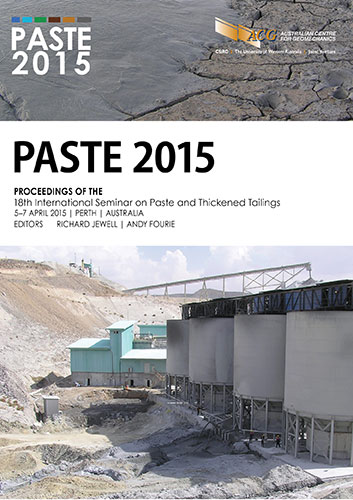A comparison of two paste plants in India

|
Authors: Lee, C; Chatterjee, G; Gandhe, A; Rao, BV; Nirvan, A; Ravikumar, DP |
DOI https://doi.org/10.36487/ACG_rep/1504_27_Lee
Cite As:
Lee, C, Chatterjee, G, Gandhe, A, Rao, BV, Nirvan, A & Ravikumar, DP 2015, 'A comparison of two paste plants in India', in R Jewell & AB Fourie (eds), Paste 2015: Proceedings of the 18th International Seminar on Paste and Thickened Tailings, Australian Centre for Geomechanics, Perth, pp. 357-370, https://doi.org/10.36487/ACG_rep/1504_27_Lee
Abstract:
Hindustan Zinc, a subsidiary of Vedanta owns and operates the Sindesar Khurd (SK) mine and the Rampura Agucha (RA) mine both located approximately 250 km away from each other in Rajasthan, India. Both mines are underground zinc mines which are primarily mined using sublevel open stoping (SLOS) and are transitioning from the use of hydraulic fill and cemented rockfill to the use of paste fill. Although the two mines have similar mineralogy, similar tailings particle size and similar strength requirements the two paste plants had surprisingly different recipes, plant layout and equipment selection in order to accommodate substantial differences in tailings rheology, dewatering and strength properties. In addition, the two paste plants have very different distribution systems with one system requiring long horizontal pumping distances and the other having a gravity distribution system. Interestingly, all the challenging characteristics such as poor dewatering performance, low strengths, and longer horizontal distribution system all are associated with the RA mine while the SK mine enjoys better dewatering, higher strengths and a simpler distribution system. The paper describes the methodology, challenges and opportunities associated with designing and construction of a paste backfill system in India as well as an interesting comparison between two paste plants to illustrate just how sensitive the design of a paste plant is to the tailings properties. It also provides an interesting comparison at the extremes of plant design resulting from excellent tailings properties and favourable orebody geometry versus challenging tailings properties and unfavourable orebody geometry.
© Copyright 2025, Australian Centre for Geomechanics (ACG), The University of Western Australia. All rights reserved.
View copyright/legal information
Please direct any queries or error reports to repository-acg@uwa.edu.au
View copyright/legal information
Please direct any queries or error reports to repository-acg@uwa.edu.au